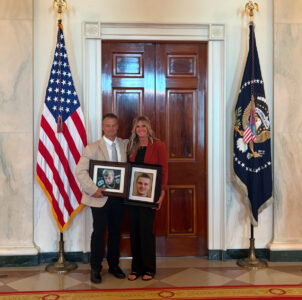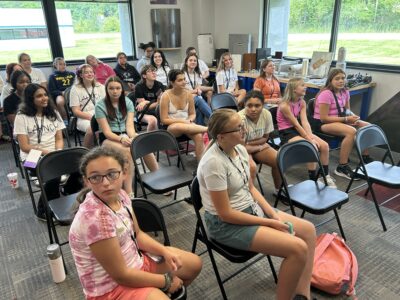New Martinsville Family Attends HALT Fentanyl Act Signing At The White House

Photo Provided Steve and Dian Estep pose with photos of their late son Drew at the White House on Wednesday.
Diana Estep understands that the HALT Fentanyl Act she watched President Donald Trump sign Wednesday at the White House won’t bring back her son Drew, who died of fentanyl poisoning in 2020 at just 24 years old. Neither will the rallies and marches she has attended over the years with her husband Steve to bring awareness to fentanyl poisoning and, hopefully, stop its encroachment into families’ lives.
Yet the New Martinsville resident also understands that all those rallies and marches and the bill signed Wednesday will help other families to avoid experiencing the loss she and her family felt.
Estep traveled with other family members to Washington D.C. after being invited to attend the bill signing. Estep was among several family members who held up photos of their late loved ones behind Trump as he discussed the bill.
The Halt All Lethal Trafficking of Fentanyl Act, passed by both U.S. Senate and House with bipartisan support, will put all fentanyl-related substances – including copycat versions – on the U.S. Drug Enforcement Administration’s list of most dangerous drugs, and classify them as Schedule I drugs under the Controlled Substances Act.
“To be quite honest, I was just awestruck,” Estep said of the White House experience. “When you see the president do those kinds of signings, it’s just so different being there in person. It was just surreal.”
Estep attended the signing with Steve, daughter Bailey Celedon, son-in-law Oscar Celedon and the couple’s child, along with Estep’s sister Rebecca Kocher. Following the signing, she said Trump stuck around the room, shaking hands with the family members who stood behind him.
He talked a few seconds with Estep, who she said asked about Drew’s photo and called him a “beautiful boy.”
Estep said Drew had struggled with substance abuse since age 18 as a way to numb the problems he faced with anxiety and attention deficit hyperactivity disorder. He had tried many times to get sober, she said, and was well regarded in the recovery community.
“Oh my goodness, Drew was a very funny, intelligent, unique personality,” she said. “He could make anybody in a room laugh. In fact, in the recovery and addiction world, that’s what he was known for, just making everybody laugh and have a better day, even in their worst times.”
Estep believes Drew was trying again to get sober when he died of fentanyl poisoning. He wanted to return to detox, she said, but needed a controlled substance in his system to qualify. So she said he bought a dose of heroin, not knowing it was laced with fentanyl, a powerful synthetic opioid 50 times stronger than heroin and 100 times stronger than morphine. Just two milligrams of the drug is considered lethal.
“There’s no amount that’s pretty much not lethal,” Estep said. “So it is poison.”
Since Drew’s death, the Esteps have been vocal in raising awareness with fentanyl poisoning. For the past three years, they have attended rallies and marches in Washington D.C. through the group Lost Voices of Fentanyl, congregating at the Washington Monument and marching to the White House to make their voices heard. Along the way, the air is filled with chants: “Whose kids? Our kids? What do we want? Action? When do we want it? Now.”
Estep said that in those years, no one had acknowledged them. Yet this year, she said they weren’t just acknowledged. With this bill, they were heard.
Estep said the bill was a “first step in the right direction,” but she does feel more needs to take place. She said Trump agreed and told the audience that the HALT Fentanyl Act was the first step and that more would follow.
“There’s a lot that has to take place with prosecutions and investigations,” Estep said. “Law enforcement has to use the new technology to get the information to solve these cases. You can get to it. So I think it’s the first step that, if law enforcement goes to get to these individuals, they have the tools to lock them up for longer periods of time.”





